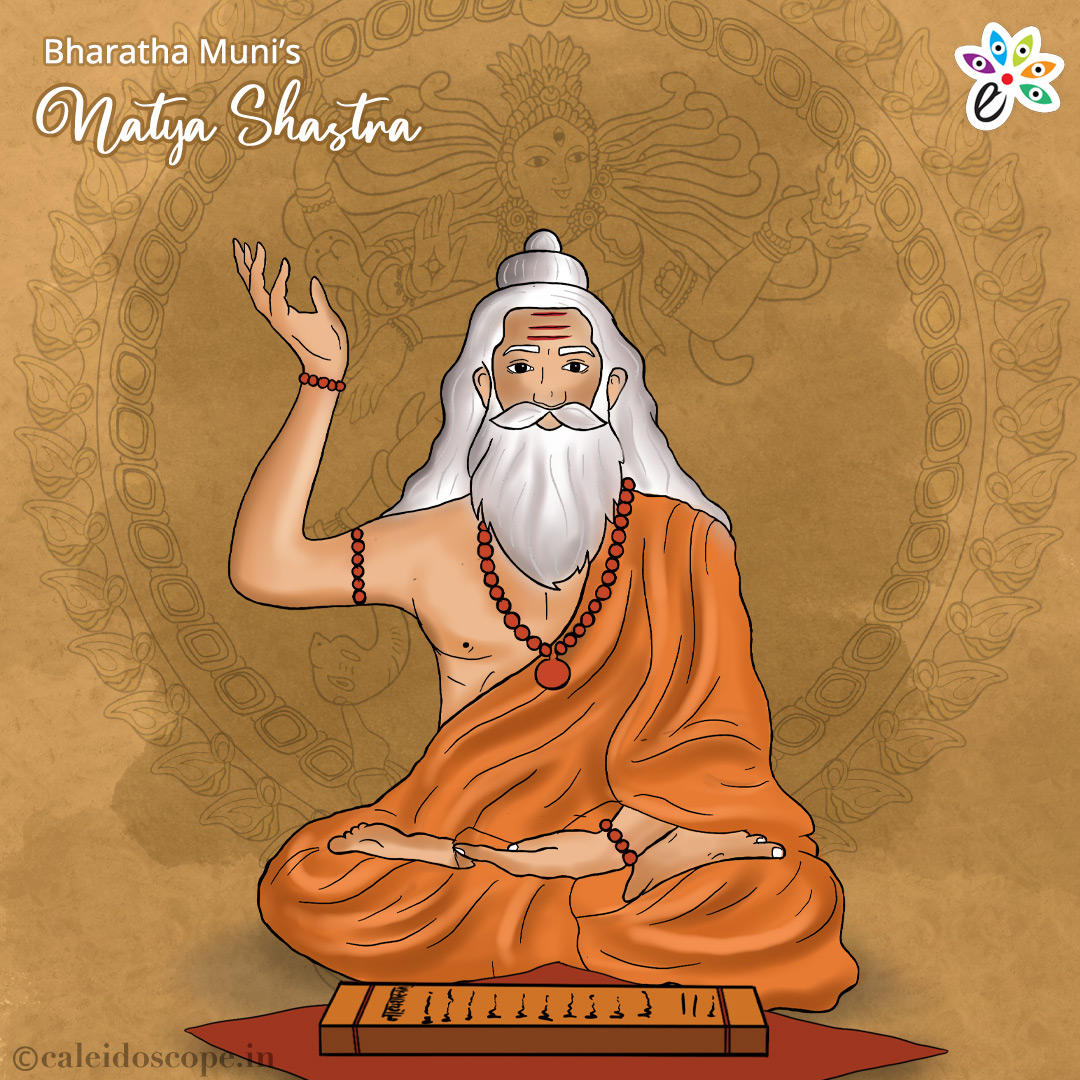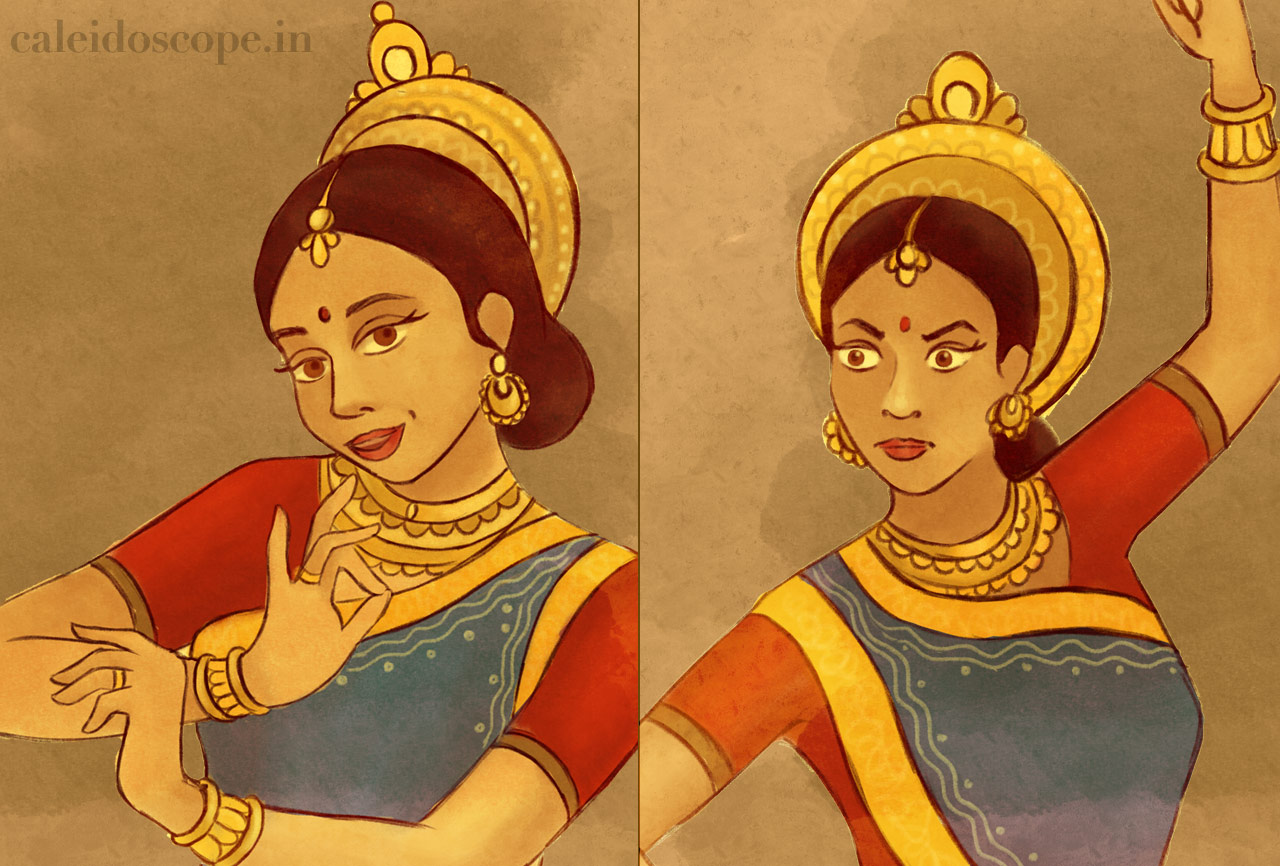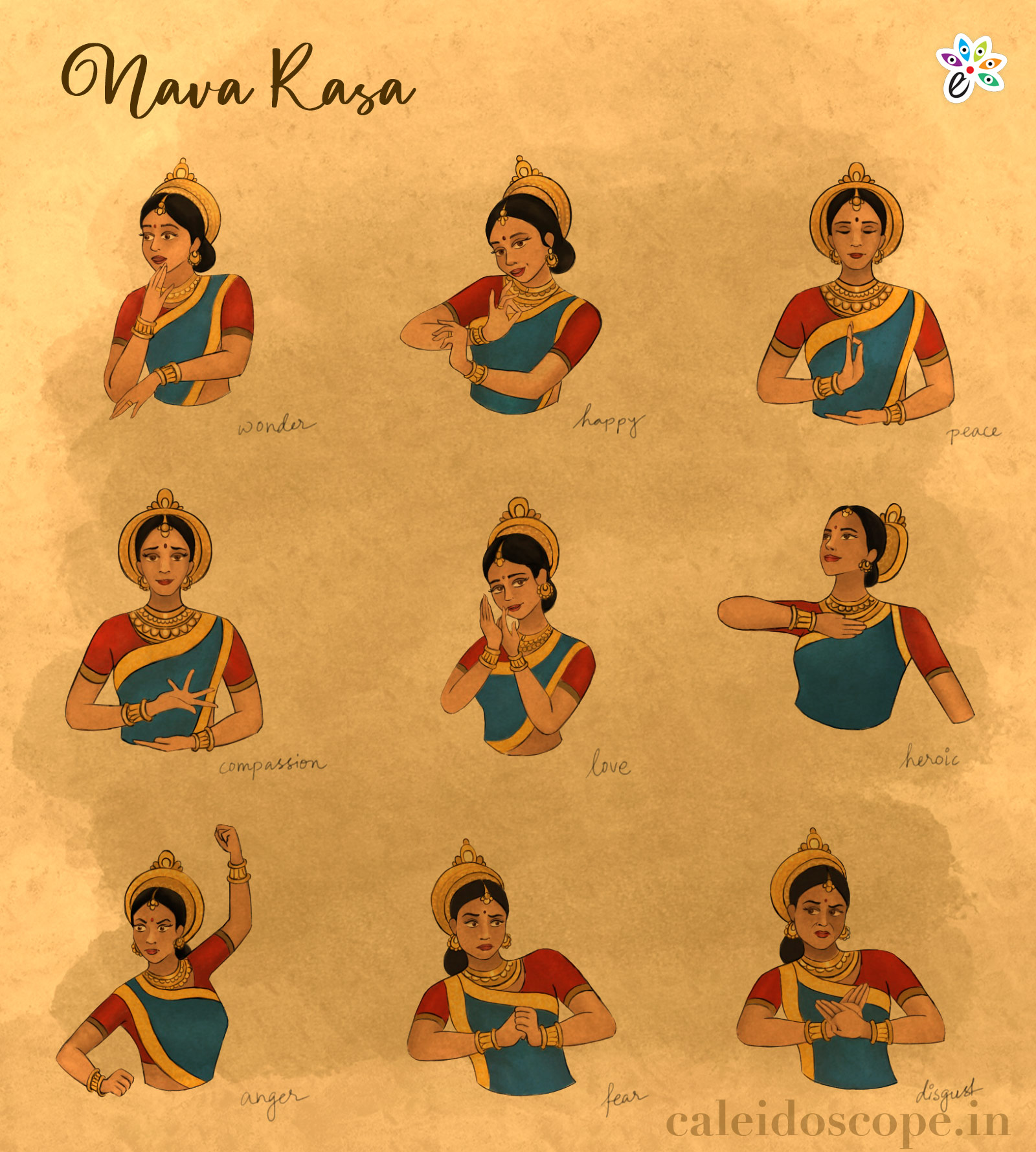
The Natya Shastra is the earliest and pioneer documentation on drama and performance art. Bharata Muni wrote the Natya Shastra somewhere around 500 BCE and 500 CE. However, it remains the most authentic dissertation, the foundational bedrock on which all the Indian Classical dances, drams and music, are based. The entire encyclopaedic treatise has 36 chapters with around 6000 poetic verses that describe the performing arts. There are many parts and elements to the Natya Shastra, however, one of its most important components is the Rasa theory.
About Natya Shastra

Natya Shastra comes from two Sanskrit words, ‘Natya’ meaning an ‘act’ and ‘Shastra’ meaning a manual or rules. It is the oldest surviving document on performing arts and has survived the ravages of time to still continue to be relevant. It has manuscripts and as per historians has been edited too along the ages. It is estimated that the first 12000 verses were originally written and different chapters are dedicated to different aspects of the arts.
Chapters 6 and 7 explain the Rasa theory, and chapters 8 to 13 are about the skill of acting, which also include dance movements, stage instruments, customs, etc. Chapters 14 to 20 talk about the plot and language of expression. Chapters 17 and 18 are attributed to poetry and the delivery of the speech and so on. The final chapters are dedicated to the different characters, teamwork, the workings of a troupe, etc.
Rasa Theory

There is an amazing amount of information and knowledge that is held in the folds of the Natya Shastra. However, we are going to try and concentrate on one of its most unique and magnificent discourses – The Rasa Theory.
The Rasa Theory is explained in chapters 6 and 7 and is one of the most important parts of Natya Shastra. This is because it in essence explains the purpose of the art. It propagates the aesthetic significance of the visual or musical art that in turn touches the deepest human emotions.
Rasa comes from the Sanskrit word meaning ‘nectar or taste or flavor.’ However, artistically it essentially means the emotions and feelings that we go through when we experience any art form. And hence it means the taste or essence of the artwork that an audience derives out of watching it. According to Bharata Muni, composition or art of any kind cannot proceed without rasa. A vital task of the performer is to entice and inspire emotions in the viewer. Thus, rasa is the sentiment that arouses an audience and this feeling goes on to connect the performer and viewer with divinity. Realising divinity can be achieved by the performer through the performance of the art, and for the viewer by the observation of the art.
The Bhavas
Bhava and rasa are both important aspects of performance and are interrelated to each other. Bhava is the state of the mind, a mental disposition or attitude of the mind. The bhavas of the performer are responsible for the rasa of the audience.
The Sthayi Bhava is referred to as the permanent or dominant emotion. But when the Sthayibhava along with the other three bhavas – Vibhav, Anubhav, and Vyabhikaribhava unite together, the resultant effect is the attainment of Rasa.
Vibhavas are the motivation that includes the storyline, the actors, and the stage, that awake the sthayi bhava. Anubhavas are the manifestations of the actors’ feelings and the vyabhikaribhavas are the transient sentiments. The Sattivc bhava is the involuntary emotions or expressions that are accompanied while experiencing the performance.
Relation Between Bhava And Rasa

Let us try and understand the interrelation between bhava and rasa through a few examples. If a beautiful girl comes up on stage the bhava that is emoted is vibhava. Her gestures, glances and moments lead to anubhavas. Now if the main mood of the performance is love, then joy and happiness are the transient emotions or vyabhikaribhavas. If the story is about separation then the vyabhikaribhavas is pain and anguish. The sattvic bhavas are involuntary expressions, such as blushes or perspiration. Because of all these bhavas, the sthyaibhava of the viewer changes into rasa.
Types of Rasa

There are many types of Rasas. Most historians agree that Bharata Muni’s Natya Shastra had eight types of rasa. The ninth rasa was added by Abhinavgupta. Each rasa has a color and a deity attributed to it. Here is taking a look at the nine different types of rasa.
1. Shringara Rasa
This rasa deals with romance, attractiveness, sexual desire and erotica. Here the sthayibhava is love. The sentiment of passion and love, the shringara rasa is affiliated with Lord Vishnu and has the color dark blue or green. The main idea is the portrayal of love between a man and a woman. However, the metaphor often transcends to the relationship between the individual and the divine. Most Classical dancers call the shringara rasa the ‘mother of all rasas.’Through this rasa, there is scope to express a plethora of emotions, including compassion, anger, jealousy and physical closeness.
2. Hasya Rasa
Hasya rasa refers to the feeling of laughter, comedy and joy. The color of this rasa is white and the deity associated with it is Pramatha or Shiva. This rasa usually arises from the shringara rasa. It is performed through comic dressing, ornaments, etc.
3. Karuna Rasa
This rasa signifies sympathy, grief, and mercy. Its color is Grey and the deity it associates with is Yama. A character experiences pain or grief due to the passing away of a loved one or because of an undesirable event. The performer portrays the emotion through a dejected face and actions which lead the audience to experience the karuna rasa.
4. Raudra Rasa
Raudra or Rudra rasa manifests rage, anger and wrath. It is associated with the color red and the God Rudra. The performance could range from topics on rape, jealousy, threats, abuse and more. The redness in the eyes and face, biting of lips, and restlessness are all vyabhikaribhavas.
5. Veera Rasa
Veera rasa is the emotion of bravery and heroism. Yellow or saffron is its color and the rasa associates itself with Lord Indra. Veera rasa is all about determination, energy and self-confidence. It is expressed with the widening of eyes and expansion of nostrils. There are three types of veera rasa – the dana veera (for the person who is a veer after donating gifts), daya veera (for the person who is sympathetic to all creeds and classes) and yudha veera (for the person who is courageous and brave.)
6. Bhayanaka Rasa
This rasa expresses fear. Its color is black and the deity it associates with is Kala, the God of Time. Bhayanaka rasa is the feeling of panic that can be brought about by danger or the anticipation of danger. To express this emotion performers raise their eyebrows, quiver their eyes, look from side to side, flare their nostrils, etc.
7. Bhibhatsa Rasa
Bhibhatsa rasa manifests the emotions of hatred and disgust. The color blue and the God Mahakala are associated with it. It is expressed on stage by squeezing limbs, rolling the eyes, spitting, or expressing disgust in other ways.
8. Abdhuta Rasa
This rasa means feeling wonder and marvel. It is associated with the color gold and the deity Gandharva. The rasa depicts the awe and wonderment that one feels when in contact with beauty or the divine. It is further categorized into Divya Abdhuta Rasa (expressed when seeing the divine) and Anand Abdhuta Rasa (expression of joy).
9. Shantha Rasa
The ninth and final rasa is the Shantha rasa, which most scholars agree was added by Abhinavgupta. This rasa manifests the feeling of serenity, peace and joy. The color Jasmine and Lord Narayana are associated with it. The Shantha or Santam rasa refers to the ultimate emotion of joy and bliss that is often attained on self-realization.
The Rasa theory is a fundamental cornerstone of the Natya Shastra. It is also the academic theorization, as well as the manifested execution. One can call it the soul of the performance because it is the rasa that connects the viewer with the performer. And the bond that strikes between the two, elevates the performance to the spiritual realm.






Very informative
Thanks Aarabhi 🙂
Very Helpful And Effective
Thanks Ravi 🙂